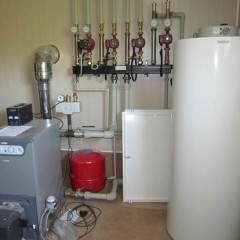Heating of septic tanks and sewer pipes of a country house
Types of cable heating
The simplest option to implement is the purchase of finished heat-insulated pipes with a laid cable. An obstacle to the implementation of this method is usually the high price of factory-made kits. From a financial point of view, it is more advisable to buy electrical equipment and mount it yourself. The heating system can be installed on new and existing pipelines. There are several options available for use on a private plot.
Resistive cable
Otherwise, this product is called a constant heating cable that does not allow power control and requires constant monitoring. The resistive cable consumes the same amount of energy and generates the same amount of heat, regardless of the external conditions. It can be single-core or two-core. In the first embodiment, the beginning and end of the conductor are connected to a power source. In the second - one end is connected to a power source, the other is equipped with an end sleeve. In addition to conductive cores, the product contains: insulation, a metal screen or a layer of high-temperature filament, an outer protective sheath, which can be made of various materials.
Features of resistive cable:
- This is the most simple and inexpensive cable product that maintains stable performance over the entire operational period.
- It goes on sale in sections of a fixed length without the possibility of cutting it into parts.
- The overlap of two cable lines will lead to their overheating, and then melting of the insulation and the plastic pipe itself.
- It is applied to pipes with a diameter no more than 40 mm.
Self-regulating cable
This product has a different device and principle of operation. Inside the insulation of polymeric materials are two conductive conductors, between which is a self-regulating polymer matrix.
Product Features:
- Changing the amount of heat generated depending on the ambient temperature prevents the possibility of overheating.
- During installation, overlaps of lines are possible.
- Cutting into sections of the required length is allowed.
Cable Management Methods
The heating of sewer pipes laid in the ground and on the surface can be external and internal, the septic tank is heated from the inside.
- The cable mounted on the outside is fixed to the pipe using aluminum tape and cable ties. Next, insulation is made with foam, from which special shells are made.
- When heating from the inside, there are some limitations - shrink tubes and end couplings should not come into contact with drains due to the likelihood of a quick loss of performance. This method is usually used in areas of small length.
The video clearly shows how to make heating the sewer using a cable:
Now you know how heating of septic tanks and external sewage pipes can be performed. We hope that the information provided was useful and understandable to you!








